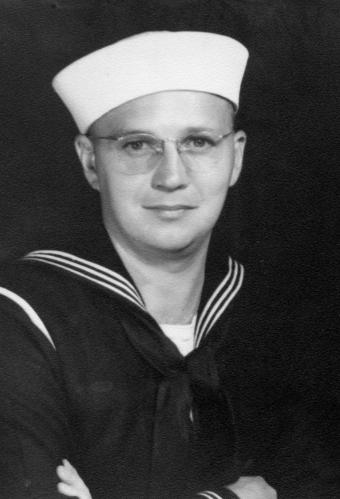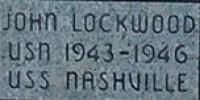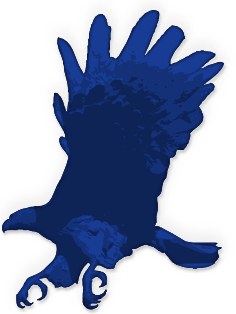Military Veterans

John Lockwood
Date of Birth
Date of Death
Brick Location
Panel Number

Biography
John Lockwood served in the U.S. Navy from 1943-1946. He was stationed on the USS Nashville.
Wikipedia History of this Vessel
World War II
From August-December 1941, Nashville was based at Bermuda for the Neutrality Patrol in the Central Atlantic. With the bombing of Pearl Harbor, Nashville steamed to Casco Bay, Maine, where she joined with a troop and cargo convoy to escort them to Iceland. She continued escort duty to Bermuda and Iceland until February 1942.
On 4 March 1942 she rendezvoused with Hornet off the Virginia Capes, and then escorted the aircraft carrier to the West Coast via the Panama Canal, arriving on 20 March at San Diego. Hornet and Nashville steamed, under Vice Admiral William F. Halsey, Jr., from San Diego on 2 April, with the carrier laden with 16 Army B-25 Mitchell bombers on her flight deck, bombers under the command of Lieutenant Colonel Jimmy Doolittle, USAAF, for the Doolittle Raid on Japan.
On 13 April, they rendezvoused with other US Navy warships north of Midway Atoll, and then they set course for Japan. When about 1000 miles away from Japan on 17 April, the destroyers of the task force were detached due to lack of fuel, and then Nashville, the other escorting cruisers, and Hornet and Enterprise made a high speed dash to the air raid launching point 500 miles from Japan.
The next day, the task force was sighted by a Japanese picket boat, which reported the presence of the carrier task force before being sunk by scout planes from Enterprise. A second picket boat was then sunk by gunfire from Nashville, but the advantage of surprise was lost. The B–25s were launched 150 miles short of the intended launching point in heavy seas. Immediately after the launch, the strike force reversed course and steamed eastwards for Honolulu. The “Shangri-La” task force returned to Pearl Harbor on 25 April 1942.
[edit]Flagship
Nashville left Hawaii on 14 May to become the flagship of Task Force 8 (TF 8) defending Alaska and the Aleutians, and arrived at Dutch Harbor, Alaska on 26 May. She steamed for Kodiak, Alaska two days later to join with other units of the task force. On 3-4 June, Japanese carrier planes struck Dutch Harbor. Nashville and her accompanying warships were unable to make contact with the enemy due to heavy fogs. Admiral Isoroku Yamamoto withdrew his diversionary force from the Aleutians after his defeat at the Battle of Midway. As the Japanese departed, they left occupying forces behind on Attu and Kiska Islands in the Aleutians. From June-November, Nashville patrolled the North Pacific Ocean, and snd participated in the attack on Kiska on 7 August, in which heavy damage was inflicted on Japanese shore installations.
Nashville arrived at Pearl Harbor on 22 November and proceeded south to the Fiji Islands on 24 December. At Espiritu Santo, New Hebrides, she became flagship of TF 67. After escorting troopships to Guadalcanal, Nashville, Helena, and St. Louis inflicted heavy damage on the Japanese air base at Munda on the night of 4 January 1943. Subsequent attacks were made on Kolombangara and none; color: #002bb8; background-image: none; background-repeat: initial; background-attachment: initial; -webkit-background-clip: initial; -webkit-background-origin: initial; background-color: initial; background-position: initial initial;" title="New Georgia" href="http://en.wikipedia.org/wiki/New_Georgia">New Georgia in the next several months. While shelling Vila airfield on Kolombangara on the night of 12 May, she suffered a powder charge explosion in one of her forward turrets, killing 18 and injuring 17.
Leaving Espiritu Santo on 22 May, Nashville arrived at Mare Island Naval Shipyard for repairs and modernization. Departing from San Francisco on 6 August, she arrived at Pearl Harbor on 12 August to join carrier task forces for strikes on Marcus Island and Wake Island during the next two months.
Nashville returned to Espiritu Santo on 25 October and for the next seven months, she shelled targets on New Guinea and the Admiralty Islands. Againse the Japanese, Nashville provided fire support for the landings on Bougainville Island and Cape Gloucester, New Britain. After bombarding Wake Island on 21-22 April 1944, Nashville provided fire support and carried General of the Army Douglas MacArthur to the amphibious operations at Hollandia (currently known as Jayapura), Tanahmerah Bay, and Aitape, on 22–23 April. On 27 May, the light cruiser was a member of the assault force shelling Biak, Schouten Islands, where on 4 June, she sustained moderate damage from a near miss while repelling a Japanese air attack.
After repairs at Espiritu Santo, New Hebrides, Nashville twice more carried General MacArthur and his staff to the invasion of Morotai, Dutch East Indies in mid-September. She carried General MacArthur on his return to the Philippines, for which she sailed from Manus 16 October. She provided fire support for the Leyte Island landings on 20 October, and she remained on station at the mouth of Leyte Gulf until 25 October, guarding the troops on the beachhead and the nearby transports. Returning to Manus Island for brief repairs, Nashville left the Admiralties on 28 November as the flagship for the Commander, Visayan Attack Force, en route to the invasion of Mindoro. On 13 December, she was struck by a kamikaze off Negros Island. The aircraft crashed into her port 5 inch gun mount, with both bombs exploding about 10 feet off her deck. Gasoline fires and exploding ammunition made her midships area an inferno, but although 133 sailors were killed and 190 wounded, her remaining 5 inch guns continued to provide antiaircraft fire.
The Attack Group Commander shifted his flag to another warship, and Nashville steamed via San Pedro Bay in the Philippines and Pearl Harbor, Oahu, to the Puget Sound Naval Shipyard, arriving on 12 January 1945, for heavy repairs. Underway on 12 March, Nashville departed westward from San Diego, California on 15 April after training exercises.
Arriving at the U.S. Naval Base Subic Bay, Philippines, on 16 May, Nashville became the flagship of TF 74. The closing months of the war were spent providing fire support for the landings at Brunei Bay, Borneo, and protecting aircraft carriers in the Makassar Straits, Dutch East Indies. On 29 July, Nashville made a brief sortie from Subic to intercept a Japanese convoy reported off Indochina, but the sortie was soon cancelled, ending her final wartime operation.
Branch:
Awards and Medals
Rank
Pharmacist's Mate, 3rd Class
Years
World War II—1943 - 1946
Duty
USS Nashville, South Pacific

